Our latest arrival - the Hyundai i30
We welcome the three-door Hyundai i30 in top-spec Sport-Nav trim. How will it stand up to London life and long motorway trips?
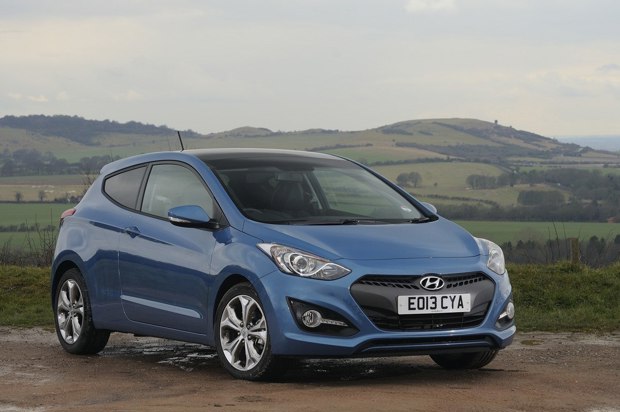
Date: 12 April 2013 | Current mileage: 1123 | Claimed economy: 68.9mpg | Actual economy: 49.7mpg
After living with the sporty MINI Coupe SD for six months it’s time to move back to something a little more mundane – the Hyundai i30. It’s not quite as mundane as the i10, though, another Hyundai model I’ve spent six months with, and one that left a positive impression. It’ll certainly be interesting to see how well the South Korean company performs at the more premium end of the market.
Our i30 is a three-door with the 1.6 CRDi engine in its most powerful 128PS form. We’ve gone for the very top trim level, too – Sport-Nav. The only optional extras on top-trim cars are a panoramic sun roof and metallic paint – boxes we ticked. The result is a very handsome car which it really suits the metallic Aqua Blue paintwork, and the contrast of the panoramic roof makes it all the more striking.
Going for a top model with optional extras means a pretty steep price tag though - £21,530 in fact. At that price, many will ask why you wouldn’t pick a Volkswagen Golf instead. But rather than producing a budget alternative Hyundai has decided to offer a car that competes on value, rather than price. That means a very impressive array of standard equipment.
Key features include Bluetooth connectivity, automatic wipers and lights, touch-screen sat nav and infotainment screen, cruise control with speed limiter, electrically folding door mirrors, half-leather upholstery and a reversing camera. Spec a Golf up to that level and you’ll be paying at least £1000 more for a less powerful 105PS car, and you’ll miss out on the nice panoramic roof. Which is better? That’s an argument for another day.
First impressions are good, though. The cabin is spacious and neatly styled and it took no time at all to get comfortable behind the multi-function wheel. There’s even space in the back for a six-foot passenger, despite this being a three-door model – that’s excellent news after spending so long with a two-seater coupe!
There’s plenty of storage space in the cabin, too – the glove compartment is large, there’s a big centre storage bin behind the handbrake and the door pockets have space for bottles. There are also plenty of little trays for parking change and there are two drinks holders. That’s all good news for someone like me, who spends all their time driving up and down the motorway and needs to be able to keep things within reach.
In fact, the only thing that didn’t manage to impress on first inspection was the wheels. They’re 17-inch, which is good for road comfort, and they fill the wheel arches nicely and they have some pretty nifty looking chrome inlays, but they show the dirt terribly and on closer inspection they’re not chrome at all, they’re plastic!
That’s a small niggle though. The overall impression left by my first few days with the new i30 is one of solidity and quality, which hopefully bodes well for the next six months. And fingers crossed the summer is warm enough to make the most of that panoramic sunroof!

Space, man
After six months with a two-seat coupe I’m really starting to appreciate the space in our new Hyundai, but I'm still getting used to some of the niggles.
Date: 26 April 2013 | Current mileage: 1693 | Claimed economy: 68.9mpg | Actual economy: 49.5mpg
Our old MINI Coupe might have been reasonably practical for a two-seater, but everything is relative. There were dozens of occasions on which it would have been nice to carry a second passenger or fold the seats forward and boost boot space, but, alas, there were no rear seats to fill with passengers or to fold down.
With the new i30 there are, though, but in honesty I wasn’t expecting much from them. Our car is a three-door, so I presumed the back seats would be too small for even the smallest of people and that folding them down would only give enough room for a couple of shopping bags. Thankfully I’ve been proved wrong.
Indeed, over the past few weeks the i30 has been a veritable delivery van – flat-pack chest of drawers from Ikea and most of an apartment move fit easily into the back, although loading and unloading is a bit of a pain thanks to a high load lip. On top of that we went on a trip to the American Diner with a full payload of grown adults in the car and it managed with ease.
So if you fancy the three-door’s stylish lines but you’re worried about practicality then don’t write it off. Having said that getting in and out of the back seats is a little bit tricky- but for occasional use or for children it shouldn’t be a problem. In fact, problems have been pretty difficult to find full stop so far.

One thing that hasn’t lived up to expectations, however, is fuel economy – the advertised 68.9mpg is something of a distant dream. Currently the car is averaging 49.5mpg, but that’s down to carrying bulky loads and a little bit of ‘driver error’ – the car is so refined at motorway speeds in fifth it’s easy to forget to go for sixth.
It does creep up as high as 52mpg if you drive like a saint, but that’s still a long way short – our old MINI Coupe was more powerful, with a larger engine and yet had better fuel economy. I do think the figure will improve with warmer weather and as the engine wears itself in, though, because it hasn’t even passed 2000 miles.
The only other annoyance is the infotainment – it won’t Bluetooth to my iPad, which contains all of my music. Thankfully there’s an AUX-in port so I can still listen to it, but I can’t skip tracks from the steering wheel. The sat-nav, too, is a little frustrating. The voice over completely mutes music, which is irritating when you’re listening to a good song.
It also looks way too far ahead for traffic issues on a long route, offering long detours to avoid jams that will have likely cleared up by the time you get to them. Obviously that’s not a huge problem because you can just ignore the detour and carry on. On the plus side you can program the navigation without even looking at it, thanks to accurate voice control.
But none of these problems are really too big. The fuel economy might be short of the official figure but it’s likely to improve and it’s still pretty frugal, while the infotainment issues are just niggles that you get used to fairly quickly. So far the practicality, refinement, quality and comfort have far outweighed any annoyances.
Petrol or diesel?
You wouldn’t usually buy a diesel car to get around town – but that’s what our i30 has been doing recently - does it still make sense?
Date: 10 May 2013 | Current mileage: 2014 | Claimed economy: 68.9mpg | Actual economy: 49.1mpg
The usual advice if you’re buying a car is to avoid diesel engines if you tend to do a lot of short trips. Initially that was the idea with our i30 – most of my journeys were 100+ miles at the weekend to visit family, but following a change in circumstances most of those high-mile trips are no longer necessary.
Instead I’m tending to cover three or four miles at a time every few days – but so far the i30 is coping perfectly well. Thanks to the gearing it’ll more or less drive itself at 30mph in fifth gear, just chugging along at tickover. Obviously that’s not much use in traffic, but if the streets are clear it makes urban trips fairly painless.
In fact there are some touches that make the i30 a genuinely great car for town – parking in tight spaces is a doddle thanks to parking sensors, a reversing camera and a ‘light’ steering setting, plus the soft suspension makes speed bumps and potholes bearable – and there are plenty of those in London.
There are some other niceties, too. Having made a trip to Richmond I found myself stranded in a one-way street, trapped by an HGV that was quite clearly far too big to be parked where it was. I worried that the car wouldn’t fit through the gap, but thanks to electrically folding door mirrors I manage to squeeze through.
Those door mirrors are folded by a button in the car, so you can operate them when on the move to get through tight gaps or to get into a small garage. Unlike some, though, they don’t automatically fold when you lock the car - not that it really matters.
There's also a really nifty little holder in the sun visor so you can store your parking tickets, which means when you get to the barrier to get out of the car park you don't have to spend five minutes looking for the card, because it's right in front of your face. Clever.

Perhaps the biggest concern with making a lot of short trips in a modern diesel car is the affect it has on the diesel particulate filter (DPF). DPFs are designed to ‘store’ hydrocarbons (soot, to you and I) which are then burnt off when the DPF reaches the required temperature.
The problem with short runs is that the DPF doesn’t ever get to the required temperature and so it gets clogged up with all the soot and then fails - and it’s not a cheap repair. Thankfully I still get to make enough long trips on the motorway to allow the i30’s DPF to do its job properly, so it shouldn’t pose a problem.
Hopefully it wouldn’t be a problem anyway – in Ask HJ we’ve had no serious reports of DPF issues with i30s. That said, if you tend to drive short distances it’d take a very long time for the diesel model to pay itself off, since it costs £1995 more to buy over the petrol version in the first place.
Based on the Real MPG figures for the petrol engine (41.7mpg) and the 128PS diesel (56.1) at an average petrol cost of £1.31 per litre and an average diesel cost of £1.38 per litre it would take eight and a half years to pay the extra £1995 off, based on an annual mileage of 7500 miles. So do some maths before you buy unless you do some serious annual mileage!
Evolution of the i30
Hyundai doesn’t have the long-running lineage of many brands but it’s interesting to see how the i30 has evolved from the Pony.

Date: 24 May 2013 | Current mileage: 2651 | Claimed economy: 68.9mpg | Actual economy: 51.1mpg
Most European car manufacturers are long established, with a lineage that stretches back decades. Take Ford – if you follow the evolution of its current Focus through time you’ll be able to trace it back over 100 years through cars like the Escort and Prefect to the Model T.
Hyundai isn’t as well established, though. The company was formed in 1947 but didn’t delve into the world of cars until 1967 when it started production of the Cortina, which was built under licence from Ford. It wasn’t long until Hyundai decided to build its own model, though.
But you can’t just dive in and start welding metal together, so the Korean company hired some old-hands from Austin in Britain. The result, in 1975, was the Pony – a five-door hatchback with a mishmash of components from brands like Mitsubishi and Ford. It was built until the mid 1980s and then replaced by the Pony X2.
The Pony was a low-price car – a budget alternative to more established vehicles. That was reflected in the way it looked and the way it drove, because it wasn’t particularly good in either regard. As transport it managed fine, but it was unsophisticated and hardly a machine to aspire towards.

Both the Pony and Pony X2 were sold in the UK, but fewer than 1000 are left on the road. Interestingly it took the ten years from 1975-1985 for Hyundai to produce its first 1m cars – it now builds more than 1.6m a year in its Ulsan plant alone.
By the 1990s Hyundai was building several models including the Scoupe, a two-door ‘sports’ car and the Sonata – a large saloon. There was no direct 1990s equivalent of the i30, but the nearest thing was the Lantra. It was far from the last word in quality, but it was reasonably popular as budget cars go.
It wasn’t, however, as popular as its successor. The first generation i30 was introduced in 2007 and was a huge step forward for Hyundai. Rather than a budget alternative it was a genuine contender, offering good quality and value for money, thanks to a decent level of standard equipment.
Its rise in popularity coincided with the scrappage scheme, which saw hundreds of people moving into a new car – often a Hyundai because of competitive offers – for the very first time. It wasn’t, however, the most stylish car. Rivals like the Ford Focus and Vauxhall Astra had more attractive cabins and more interesting exterior styling.
That’s something Hyundai designers set to work in fairly promptly – the current i30 manages to match most rivals in all of the important areas. It features up-to-date technology wrapped in infinitely more stylish bodywork, and even comes with some luxurious touches – like the glass roof fitted to our car.
It’s a far cry from the Pony. Track the Volkswagen Golf back to the 1970s and you’ll see a steady, slow evolution from the boxy original to the current model with its smooth, understated styling. The evolution of Hyundai’s models has been much more radical.
It had to be, really. A new brand company has to work hard to compete with the establishment – but it seems Hyundai has managed, given how popular its cars are with visitors to honestjohn.co.uk. In fact its ix35 is the most popular car in terms of page views of any car on the whole site – which makes it our Car of the Year 2013.
Missing features
The Hyundai i30 is well-equipped as standard, particularly in the top trim level – but there are a few irritating omissions.

Date: 7 June 2013 | Current mileage: 3068 | Claimed economy: 68.9mpg | Actual economy: 50.1mpg
One of the biggest selling points of the Hyundai i30 is its generous standard specification. Our car is a top-of-the-range Sport Nav which comes with more or less everything you could need, including sat nav, automatic lights and rain sensitive wipers.
In fact there aren’t many optional extras available to choose from – just metallic paint and a panoramic sunroof, both of which are fitted to our car. There are, however, a few things that Hyundai doesn’t offer, whether as standard equipment or as an optional extra.
First of all there is no DAB radio – something that is becoming increasingly common and popular with car manufacturers. Having experienced the improved audio quality and better choice of radio stations on offer while driving other cars it seems surprising that Hyundai doesn’t even offer it as a cost option.
Secondly there is no option of active safety technologies like active cruise control, blind spot monitoring or collision mitigating braking – features available on the likes of the Ford Focus and Volkswagen Golf. It’d be nice to see them as optional extras if not as standard gear.
It’s not the end of the world, though. Euro NCAP still awarded the i30 a five-star safety rating and it managed to score 90% for adult and child occupant safety, which is laudable. Additionally, active safety technologies are still fairly new – they’re currently only offered by the minority of car manufacturers. Watch the NCAP tests below.
One thing that is less forgivable is the way Hyundai offers its stop/start technology. It’s only fitted to ‘Blue Drive’ 110PS models, rather than as standard across the range – and if you ever drive in town you’ll understand how useful it is to save fuel in heavy, slow moving traffic.
On balance I suppose some people genuinely don’t want it and it does cost money, which would make the top models less competitive on price. But the fact it’s not even available above the mid-range Active trim level is confusing and it means our 128PS top model can’t be bought with stop/start.
Given the type of trips I’ve been making recently – mostly fewer than 20 miles with at least half spent in traffic-light heavy West London – I imagine I’d get a few extra mpg with stop/start installed. In fact, you can actually see the average fuel economy figure slowly dropping the longer you spend in town!
The only other omissions are niggling and unimportant – there’s no option of full-leather, for example, and there aren’t that many colours in the palette. It’d look good in a green or brown, if you like that kind of thing. There are a few nice shades, though, like our optional metallic blue.
To be fair to the Hyundai, though, it does offer most of the equipment people need, and the stop-start issue wouldn’t affect someone who had the foresight to realise they’d probably need it in the future and so would specify the correct engine.
Golf or i30?
Our i30 is certainly an impressive car – but anyone seeking a new family hatch will have the Volkswagen Golf on their shopping list. How does it stack up?
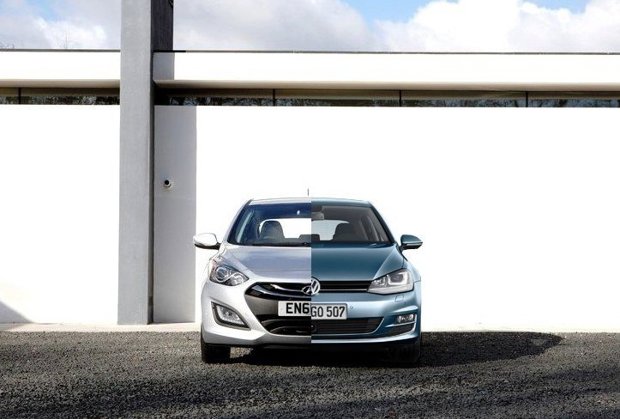
Date: 21 June 2013 | Current mileage: 3189 | Claimed economy: 68.9mpg | Actual economy: 49.7mpg
If you’re in the market for a family hatchback there are a few cars aside from the Hyundai i30 that will almost certainly be on your test drive list, including the Ford Focus and the critically lauded seventh generation Volkswagen Golf.
The Golf is arguably the benchmark car in its class – it sets the bar other manufacturers strive to match when building their family cars. Now we’ve driven both cars back to back we can find out exactly how well the i30 fares alongside its arch-rival.
For the same £20,410 as you’d pay for our fully kitted-out i30 you can get a Golf SE BlueMotion diesel. On paper you get better fuel economy from the Volkswagen at 74.3mpg, versus 68.9mpg for the i30 – but the i30 has more power at 128PS, 23PS more than the Golf. Evens.
That said, the Golf doesn’t feel any worse for it. In fact, the Golf is a nicer car to drive despite a performance deficit. The steering is neater and smoother, the ride is better damped (though firmer) and the gear change is neater and more precise. On top of that you get better refinement from the Volkswagen.
That’s not to suggest the i30 is poor to drive, however. Indeed it, too, is smooth to drive with light controls – but it doesn’t feel quite as well-judged or complete as its German rival. The i30 does have the Golf trumped in one area, though – standard equipment.
£20,410 pays for a top trim i30 including all of the optional extras. That means our car has a panoramic roof, metallic paint, sat-nav, LED running lights, electrically folding door mirrors, half leather seat trim, and dual-zone climate control – all of which cost more on the Golf.
Once again, though (there’s a trend developing here), that’s not the full picture. The Golf has some nice touches unavailable on the i30, including DAB radio and electric parking brake with hill-hold assist. Importantly there’s also an excellent adaptive cruise control system that isn’t offered on the i30.


Volkswagen has built a reputation for quality, so when you sit in the Golf it’s no surprise that everything is tactile and robust. The surfaces are trimmed with a soft-touch plastic that manages to feel both hard-wearing and plush, plus all of the controls feel perfectly weighted.
It’s something Hyundai has tried very hard to match with the i30. For the most part it has succeeded, but it isn’t quite all the way there. The centre stack, for example, isn’t as neatly laid out as it is in the Golf, nor does the selection of materials manage to feel so solid.
But it’s very important to remember that just a few years ago no Hyundai model would even come close to giving a Volkswagen a run for its money. Hyundai might not quite match Volkswagen for material quality or prestige, but the gap has closed tremendously quickly and it continues to close with every new car the Korean firm produces.


So if you’re looking for a family hatchback then check around. The i30 might not be as polished as the Golf but it’s very close – and what it lacks in polish it makes up in value. Ten years ago you’d never have expected to hear that about a Hyundai.
To read a full review of the Volkswagen Golf, click here.
Tested for durability
Hyundai handed an i30 over to 25 kids, armed with sand, juice and muddy wellies to see how durable it is.

Date: 5 July 2013 | Current mileage: 3763 | Claimed economy: 68.9mpg | Actual economy: 48.6mpg
To keep up with the competition, car manufacturers have to build very durable vehicles - but it’s a fine art. Creating something that’s durable yet manages to remain plush and luxurious is far from easy – and it’s harder still to prove to buyers that something brand new and shiny will stand the test of time and look good in years to come.
It’s fair to say that we’ve been a little bit unfriendly to our i30– it wasn’t washed between April and July but it did manage to shine like new after a quick buff. But how will you know just how durable the paint finish and interior upholstery is if you’re looking a spotless, brand new car in the showroom?
Well Hyundai has thought of that – by letting a classroom of school kids loose on an i30 Tourer. You might not expect a manufacturer to be so daring with one of its cars, but obviously the company was confident it’d withstand paint, sand, yoghurt and whatever else could be chucked at it.
25 kids spent the day testing how durable the i30 really is, smearing mud on the exterior panels, bouncing on the seats in muddy wellies, fiddling with windows, mashing bananas into the seats and spilling juice all over the place. They also had the chance to make the boot floor into a ‘beach,’ complete with sand castles.
Generally they made the most of their time doing things they’d otherwise get a thorough telling off for – but this time around they got away with it. After ‘testing’ was completed the car was washed inside out and polished – surviving with just a few scratches. Watch the video below to see just how much of a beating the i30 survived or click here to see all the updates on our i30.
Where has the i30 been?
We've some of the routes over which our i30 has travelled on a map so you can see how it performs over a variety of road types.
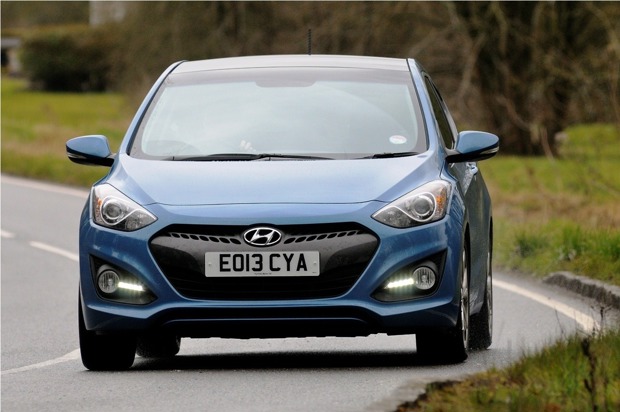
Date: 19 July 2013 | Current mileage: 3936 | Claimed economy: 68.9mpg | Actual economy: 48.4mpg
I've covered a few thousand miles in the i30 now, over a good mixture of roads. It's generally pretty competent at whatever I ask it to do, with the odd irritation here and there. To show how the car performs over a variety of routes I’ve created a map, which shows the routes and outlines how the car performed.
It’s interactive, so click the colours to find out more, or scroll down for more in depth route information.
Around London (Red)
The i30 has covered a lot of distance in the capital and it manages OK - but an auto would be easier to live with and the addition of stop/start would save fuel - only 'Blue' models come with stop/start as standard and when you're constantly stopping at red lights it'd be nice to stop burning diesel.
To the north (Green)
A mixed route (Blue)
A typical test route (Pink)
To the Goodwood Festival of Speed (Turquoise)
To Stansted Airport (Orange)
The launch of the Chevrolet Trax took the i30 to be valet parked at Stansted Airport - and it quickly became obvious the car needed a wash! Nonetheless it came back with a sheet of blue paper in the footwell to keep muddy footprints at bay. Driving the Trax also revealed how well Hyundai is doing - the Korean-built Chevrolet doesn't have a cabin that's nearly as plush or well made.
Sat nav test (Purple)
A day trip to Brighton clashed with a bicycle race, which meant a lot of slow-moving traffic on the way to the seaside. The sat nav couldn't calculate a quicker route when it detected the jam, so we turned towards Hove and gradually it pointed us in the right direction, saving some time. It'd have been nice if it did that automatically - but at least it kept correcting itself as we made our own progress.
We also had to drive around in an overpriced underground car park with spaces designed Little Tikes Cozy Coupes. That's always a stressful experience but, thanks to folding mirrors and a reversing camera it wasn't the end of the world - though slightly better over-shoulder visibility wouldn't go amiss.
Extra precaution
Driving a big mixture of petrol and diesel cars means there’s a higher chance of misfuelling, so we’ve fitted a device to prevent it.
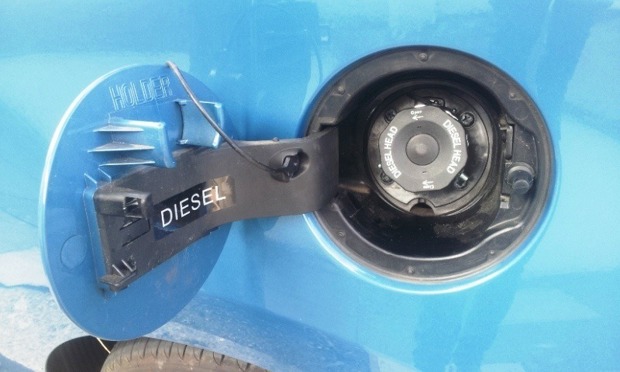
Date: 2 August 2013 | Current mileage: 4365 | Claimed economy: 68.9mpg | Actual economy: 48.1mpg
I drive a lot of different cars – it’s part of the job – and that means a mixture of petrol and diesel powered engines. Fortunately because I’m forever chopping and changing I tend to pay special attention when I get to the pumps to make sure I don’t pick up the wrong one.
However if you look at the Ask HJ section of the site you’ll see that lots of typically cautious people often accidentally pick up the wrong nozzle – often they usually green petrol pump is black with a different coloured sticker and it’s very easy to get distracted.
So I decided to take a bit of an extra precaution for those occasions when I am distracted by fitting a ‘Diesel Head’ so I don’t accidentally pump petrol into the i30’s diesel tank. It’s a fairly cheap and simple device that slips over the neck of the filler spout in the car and locks into place with a few screws.
After that the nozzle will only accept diesel fuel fillers – petrol ones won’t fit through the hole thanks to a clever spring-loaded door that only opens for the ever-so-slightly wider nozzle on a diesel pump. It’s simple but effective. The only issue I had was getting it fitted – it’s a fiddle to say the least – but once it’s on that’s the end of it, you can forget about it and get on with driving.
Putting petrol in a diesel car can be seriously damaging to engine components like the fuel pump and if you accidentally misfuel and notice before driving the cost of calling someone out and getting the tank drained is higher than the £35 it costs to buy a Diesel Head, so it seemed like a sound idea.
Aside from that addition, the i30 is performing as ever – it’s smooth, comfortable and easy to drive. It’s absolutely filthy though, both inside and out... so perhaps it’s time to get it washed.
Disappointing economy hasn’t improved
When our i30 arrived it wasn’t delivering particularly good fuel economy – which could have been down to the low mileage. Sadly, it hasn’t much improved.
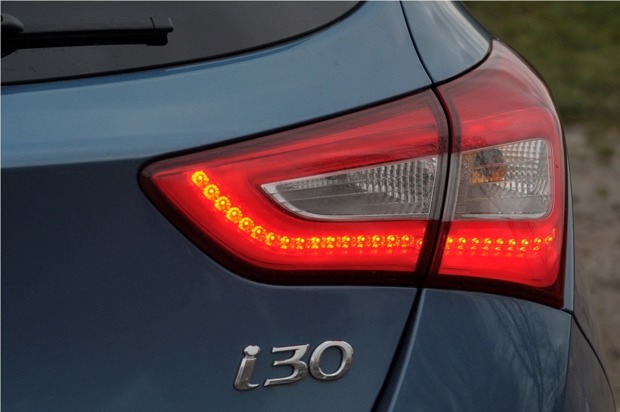
Date: 23 August 2013 | Current mileage: 5362 | Claimed economy: 68.9mpg | Actual economy: 47.9mpg
Car manufacturers have to jump through quite a few hoops to get their cars in show rooms. EU regulations cover everything from airbags to the height of headlights, but the rules that affect car owners most are those covering fuel economy and emissions.
The only figure a car manufacturer can quote for fuel economy comes from the combined cycle test, which covers a set of distances at set speeds. The result is, often, a disparity between the lab economy and real world economy – you can’t buy a new car and really expect to match the quoted figure.
Nonetheless, I’d have expected a bit more from the i30. When it arrived I was pleased to read the official figure of 68.9mpg – with my realistic head on I thought it ought to manage around 54 or 55mpg. Initially it was typically returning 48-49 but I wasn’t too alarmed – the engine was still tight having only covered around 500 miles.
Now, though, it’s still delivering about the same average economy. That is partly my fault – I do a lot of short trips of less than 10 miles – but there are still plenty of long motorway trips to theoretically improve the average but it’s not working – perhaps it’s because the Sport Nav model has standard tyres and lacks a stop/start function.
Based on 12,000 miles per year a 55mpg car would cost about £1390 in diesel at a cost of £1.40 per litre – at 48.1mpg the same mileage costs £190 more. Over a few years that can really add up. That said, the i30 is still fairly efficient and the rest of the models in the range seems to do reasonably well in our Real MPG section.
So the message, really, is to make sure you buy the right model. If you’re going to do a lot of mixed driving a diesel might be fine, but if you’re spending a lot of time in town then you might need the less powerful model with its fuel saving technology.
For my driving a petrol-powered model would probably be better. When the car arrived I tended to cover nothing but motorway miles so it all made sense. Now, though, I drive in London almost every day and the stopping, starting and short trips are taking their toll on my average economy. The cheaper cost of unleaded might would probably work in my favour.
Three doors or five?
During my time driving the i30 I haven’t seen another three door model which is quite surprising. So is this an exclusive model?
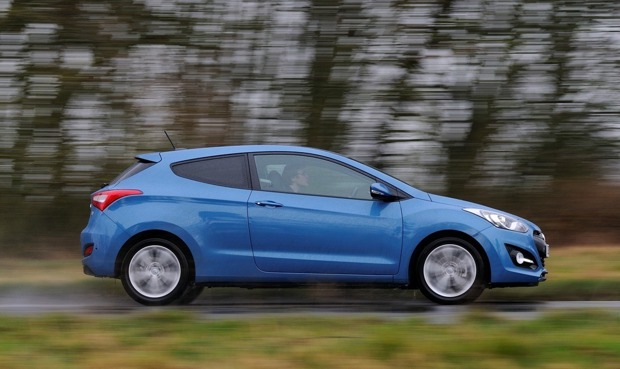
Date: 11 September 2013 | Current mileage: 6321 | Claimed economy: 68.9mpg | Actual economy: 48.1mpg
Buying a car shouldn't be a process that is upset by listening to your heart but that's never how it works. A two-seat sports car is never going to work well if you have a family of four and a dog, however the idea will always appeal. The i30 is offered in both three and five-door forms – so why would you buy the smaller three-door?
Styling wise the differences aren’t abundantly obvious. There are, of course, no rear doors on a three-door and in their place there’s an attractive window design that makes the roofline appear to slope, giving a sportier profile. Additionally, at the front there’s a black grille rather than a chrome one and there are different LED lights.
Aside from that there’s little to differentiate the two and if you don’t have children to carry that’s about where it stops – the lack of rear doors will probably be irrelevant. If you do have kids then you might think the sportier design must be sacrificed for the greater legroom and better access of a five-door – but with the i30 that’s not the case.
Typically there’s not much legroom in the back of a three door car but I recently spent a week driving a teenager around and she fit perfectly comfortably into the back seats of the three-door i30 and she didn’t have a horrible time getting in and out thanks to good sized doors and seats that are easy to adjust.

The five-door doesn't look hugely different from the three-door
However there is one irritation when letting someone in and out of the back row – the front seat doesn’t automatically return back to its original position on the seat runner. That’s irritating if you have a very specific driving position and it’ll mean the first five minutes of a trip are spent getting the seat in the right spot.
Teenagers are obviously less of a pain to get in and out of a three-door car than younger children – providing they fit – so perhaps the five-door would suit families with young children and babies a little more. That said if the only thing that keeps you from buying the sportier looking three-door is a worry about its practicality then don’t let it put you off – it’s not as tiny as you might think.
Of course if practicality is at the very top of your agenda the i30 Tourer is the most sensible choice and it still looks pretty good – it’s not too bulky and it maintains the lines of the three and five-door cars, with the benefit of a giant boot with space for dogs, holiday luggage or trips to Ikea.
But for me the three-door is the best choice – which makes the lack of them seen on the road all the more confusing. Indeed I’ve never seen another three-door model in the past six months – just loads of five-doors and tourers. Maybe Hyundai buyers tend to use their heads not their hearts.
Waving off the i30
After six months with the Hyundai i30 Sport Nav 1.6 diesel it's time to say goodbye and generally it's been a good car.

Date: 25 September 2013 | Current mileage: 7013 | Claimed economy: 68.9mpg | Actual economy: 48.1mpg
Six months, seven thousand miles and around £900 of diesel since the i30 arrived and it’s time to wave it off. That went quickly. It went painlessly too – the i30 has been very easy to live with. Comfortable, refined and relaxing to drive, it’s made long-haul motorway treks effortless and despite its diesel engine it’s performed well in town, too.
When the i30 originally arrived I tended to cover about 550 miles on the motorway almost every week with very little driving in between. That meant a diesel engine was the sensible choice, but a change in circumstances meant the motorway trips became few and far between, replaced with daily 10 mile round trips in London traffic.
Thankfully it wasn’t the end of the world – the i30 has a great suspension set up that offers excellent ride quality over potholed, speed bump covered town roads and the steering weight can be adjusted to suit tight quarters parking. Visibility is generally good, with a slightly awkward over should view the only fly in the ointment.
That’s all good news in London, where you need a dozen pairs of eyes to avoid hitting a cyclist, a rogue pedestrian or a driver with terrible lane discipline. The i30 provides its own eyes, too, thanks to a reversing camera that works well regardless of how dark it is. There are even electronically folding door mirrors – handy when parking in a narrow street.
It isn’t all good news though. Not all i30 models have stop/start, so the average fuel economy gets progressively worse on the readout whenever stopped at a red light. That’s most of the time in London. It seems a little bit silly not to install a relatively cheap fuel saving technology on every model in the range.

Indeed the biggest bugbear with the i30 has been fuel economy. The average has always been just below 50mpg, even when there’s been a lot of motorway mileage in the mix. The official combined cycle figure is 68.9mpg and aiming at getting that in reality would be very optimistic, but I expected mid 50s without too much effort. Less than 50mpg a little disappointing, though still acceptable.
Other issues are hard to find. Build quality and practicality are excellent and there’s plenty of technology, although the audio system doesn’t get on with my iPad whether I try to connect it with a wire or with Bluetooth. Normal iPods work and using a phone over Bluetooth is easy, it’s just a shame the iPad doesn’t work.
It’s a niggle, though, and one that’s pretty easy to forgive. The i30 is comfortable, refined, easy to drive and very capable in every environment, whether in town, in the countryside or on the motorway. It might not be quite as prestigious as a Volkswagen Golf and it certainly isn’t as polished – but it’s very close behind and that can only be a good thing.
The chart below is interactive and shows the key numbers from the past six months including mileage, fuel economy and costs. Click the bubbles for more info.

